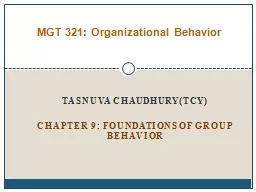PPT-Tasnuva Chaudhury(TCY)
Author : stefany-barnette | Published Date : 2017-03-31
Chapter 9 FOUNDATIONS OF GROUP BEHAVIOR MGT 321 Organizational Behavior Defining and Classifying Groups Group Two or more individuals interacting and interdependent
Presentation Embed Code
Download Presentation
Download Presentation The PPT/PDF document "Tasnuva Chaudhury(TCY)" is the property of its rightful owner. Permission is granted to download and print the materials on this website for personal, non-commercial use only, and to display it on your personal computer provided you do not modify the materials and that you retain all copyright notices contained in the materials. By downloading content from our website, you accept the terms of this agreement.
Tasnuva Chaudhury(TCY): Transcript
Chapter 9 FOUNDATIONS OF GROUP BEHAVIOR MGT 321 Organizational Behavior Defining and Classifying Groups Group Two or more individuals interacting and interdependent who have come together to achieve particular objectives. TcY. ). CHAPTER 13: Power and Politics. MGT 321: Organizational Behavior. Definition of Power. Power. The capacity that A has to influence the behavior of B so that B acts in accordance with A’s wishes.
Download Document
Here is the link to download the presentation.
"Tasnuva Chaudhury(TCY)"The content belongs to its owner. You may download and print it for personal use, without modification, and keep all copyright notices. By downloading, you agree to these terms.
Related Documents

